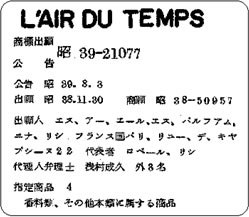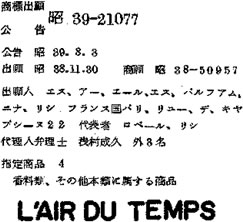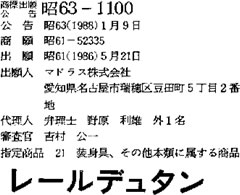L’AIR DU TEMPS CASE
What Is Likelihood Of Confusion?

Trademarks in Use

Registered Trademark
TRADEMARKS OF NINA RICCI
NINA RICCI had registration No. 661,424 (publication No. S39-021077) with respect to a mark “L’AIR DU TEMPS” for the designated goods in old Class 4: “Perfumes, and other related goods in the class” (NINA RICCI’s Registered Trademark). In addition to such a registered trademark, NINA RICCI sold perfumes “L’Air du Temps” and ![]() (a Japanese character obtained by typing L’Air du Temps in a phonetic manner) that was one of their lineup of many perfume families (NINA RICCI’s Trademark in Use).
(a Japanese character obtained by typing L’Air du Temps in a phonetic manner) that was one of their lineup of many perfume families (NINA RICCI’s Trademark in Use).
REGISTRATION BY MADRAS
On 19 December 1988, after the trademark-registration by NINA RICCI dated 12 December 1964, ![]() (another Japanese character phonetically similar to
(another Japanese character phonetically similar to![]() ) was registered as trademark registration No. 2,099,693 (publication No. S63-1100) in the name of MADRAS INC. for the designated goods in Class 21: “Personal ornaments, and other related goods in the class” (MADRAS’ Trademark).
) was registered as trademark registration No. 2,099,693 (publication No. S63-1100) in the name of MADRAS INC. for the designated goods in Class 21: “Personal ornaments, and other related goods in the class” (MADRAS’ Trademark).
Both the registered trademarks are shown below:
| NINA RICCI’s Registered Trademark | MADRAS’ Registered Trademark |
 |  |
DISPUTE IN JPO’S APPEAL STAGE
NINA RICCI filed request for appeal against MADRAS INC. with the JPO for seeking the invalidation of MADRAS’ Trademark, under Japanese Trademark Act, Article 4(1)(15), for “cosmetic utensils, personal ornaments, hair ornaments, bags, pouches” selected out of the MADRAS’ designated goods. The JPO provided a decision, however, to dismiss the request for appeal on 24 February 1997.
The ground relied upon by the JPO to reach the above decision was that NINA RICCI’s goods lineup consisted of at least 63 perfume families. A reputation for many sorts of perfume was recognized by the JPO as having been converged to/identified as a family of “perfumes,” which resulted in the established and maintained reputation.
It was concluded by the JPO that there was no likelihood that![]() at issue used for e.g. “cosmetic utensils, personal ornaments” that appeared dissimilar to “perfumes” would cause any confusion due to the fact that it was nothing but one of the marks used for such perfumes individually. In sum, NINA RICCI’s trademark right could not be extended in scope of goods to such an extent.
at issue used for e.g. “cosmetic utensils, personal ornaments” that appeared dissimilar to “perfumes” would cause any confusion due to the fact that it was nothing but one of the marks used for such perfumes individually. In sum, NINA RICCI’s trademark right could not be extended in scope of goods to such an extent.
DISPUTE IN HIGH COURT
NINA RICCI filed a lawsuit for seeking the cancellation of the JPO’s decision in the Tokyo High Court (first instance); however, it was also dismissed in the first-instance judgment on 28 May 1998.
Firstly, as to the ground relied upon by the court to reach such a judgment, the indication was recognized by the court as being famous for the “perfumes.”
| t is presumed that NINA RICCI’s Trademark in Use “L’Air du Temps” or |
Secondary, for “cosmetic utensils” and “personal ornaments,” however, a different opinion was provided by the court.
| In the cosmetic market, however, it could not be recognized that NINA RICCI’s Trademark in Use was widely and extremely famous as early as 1986, and it could not be recognized either that, if it was used for the goods: “cosmetic utensils, personal ornaments, hair ornaments, bags, pouches,” there was a likelihood of confusion in source as if such goods had been dealt with by NINA RICCI or any others having some business relationships with NINA RICCI. |

OPINION OF SUPREME COURT
As a result, NINA RICCI filed a petition of final appeal with the Supreme Court against the Tokyo High Court’s judgment. The Court’s opinion is shown below.
- First Of All, What Is Purport Of Article 4(1)(15) ?
The provision “the trademark…likely to cause confusion in connection with the goods pertaining to a business of another person” under Japanese Trademark Act, Article 4(1)(15) was explained as follows:
| It is reasonable to construe the trademarks falling under Article 4(1)(15) as including not only a trademark which, upon being used for the designated goods, is likely to cause confusion in connection with the goods pertaining to another person but also a trademark which is likely to cause confusion in connection with the goods pertaining to a business of a proprietor having a close business relationship with said another person such as subsidiary and affiliated companies, or having a relationship in belonging to a group running a merchandizing business for the same indication (hereinafter, referred to as “likelihood of confusion in a broad sense”). |

On the grounds that:
| The provision of item 15 of Article 4(1) purports to maintain the business reputation of those who use the trademark, and protect the interests of the consumers, by preventing the so-called “free ride” on well-known and famous indications and the so-called “dilution” of such indications so as to protect a goods-identification function of the trademark. It follows from the purport of the provision that, in order to protect the reasonable interests of those who use the well-known or famous indications, in accordance with the changes in business and markets such as the diversification of business management, the formation of a group of companies tied together in merchandizing business for the same indication, the establishment of famous brands, a trademark even with a broader sense of likelihood of confusion should be prevented from being registered. |
- What Is “Trademark With Likelihood Of Confusion” ?
In view of the above, the criteria for determining whether or not there is any “likelihood of confusion” were summarized as follows:
- Degree in similarity between the trademark and other persons’ indications;
- Degree in well-known property, famous property, and originality of other persons’ indications;
- Degree of relation in property, application purpose, or objective of goods between the designated goods of the trademark and goods pertinent to other persons’ business;
- Commonality with respect to the goods between the traders and between the consumers, or the like, and business-transaction circumstances;
- In light of the above, a comprehensive determination should be made with reference to carefulness paid normally by the traders and consumers for the designated goods of the trademark.
- How Can It Be Applied To Present Case?
- Appearance and Sound?
MADRAS’ Trademark is identical at least in sound to as one of NINA RICCI’s Trademark in Use, and is also similar in appearance to this
as one of NINA RICCI’s Trademark in Use, and is also similar in appearance to this  Furthermore, in view of the indication itself and the designated goods of NINA RICCI’s Registered Trademark, it may safely be said that
Furthermore, in view of the indication itself and the designated goods of NINA RICCI’s Registered Trademark, it may safely be said that  could be generated via sound in French from NINA RICCI’s Registered Trademark, and therefore, MADRAS’ Trademark and NINA RICCI’s Registered Trademark are identical to each other in sound.
could be generated via sound in French from NINA RICCI’s Registered Trademark, and therefore, MADRAS’ Trademark and NINA RICCI’s Registered Trademark are identical to each other in sound. - Famous property? Originality?
NINA RICCI’s Trademark in Use and NINA RICCI’s Registered Trademark have been a trademark, which is famous as indicating one of perfume families of NINA RICCI as well as original, among the traders dealing with perfumes and the consumers interested in upmarket perfumes. - Commonality of goods?
The goods of MADRAS’ Trademark subjected to the request for invalidation appeal “cosmetic utensils, personal ornaments, hair ornaments, bags, pouches,” selected out of the MADRAS’ designated goods, are closely associated with “perfumes” principally in women’s decoration purpose, and therefore, there is a considerable overlap between the consumers with respect to both the goods.
- Appearance and Sound?
- Conclusion
It was held by the Court that, in light of the above, upon being used for “cosmetic utensils, personal ornaments, hair ornaments, bags, pouches,” MADRAS’ Trademark is likely to cause confusion in a broad sense in connection with such goods and the goods pertaining to a business of a proprietor having the above-described close business relationship with NINA RICCI, for the traders and consumers.
